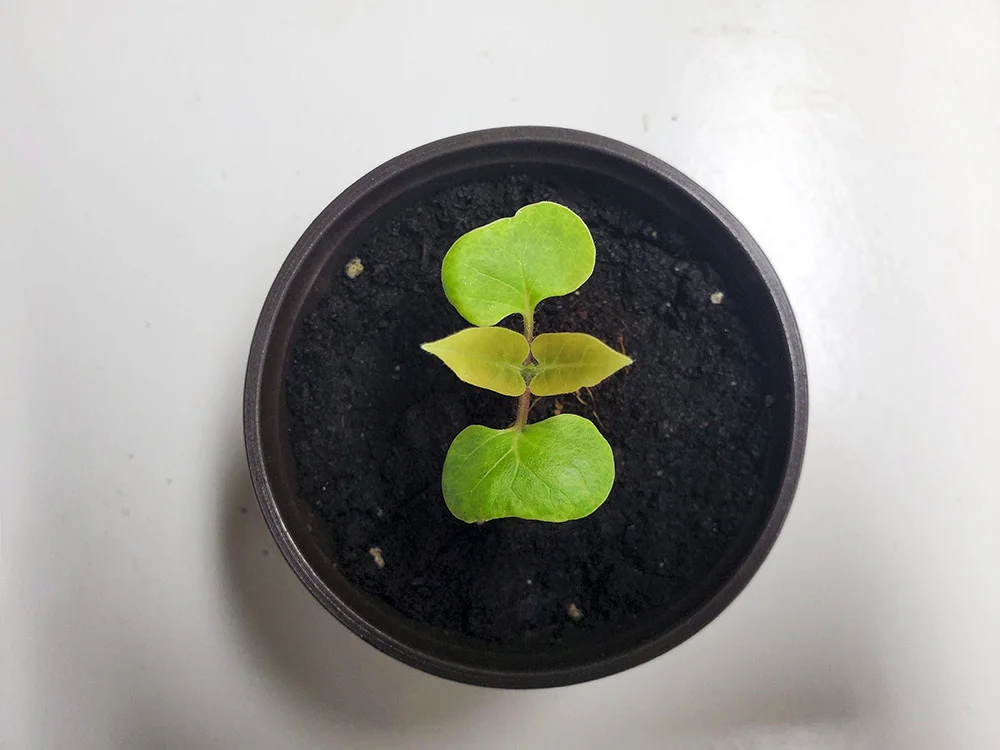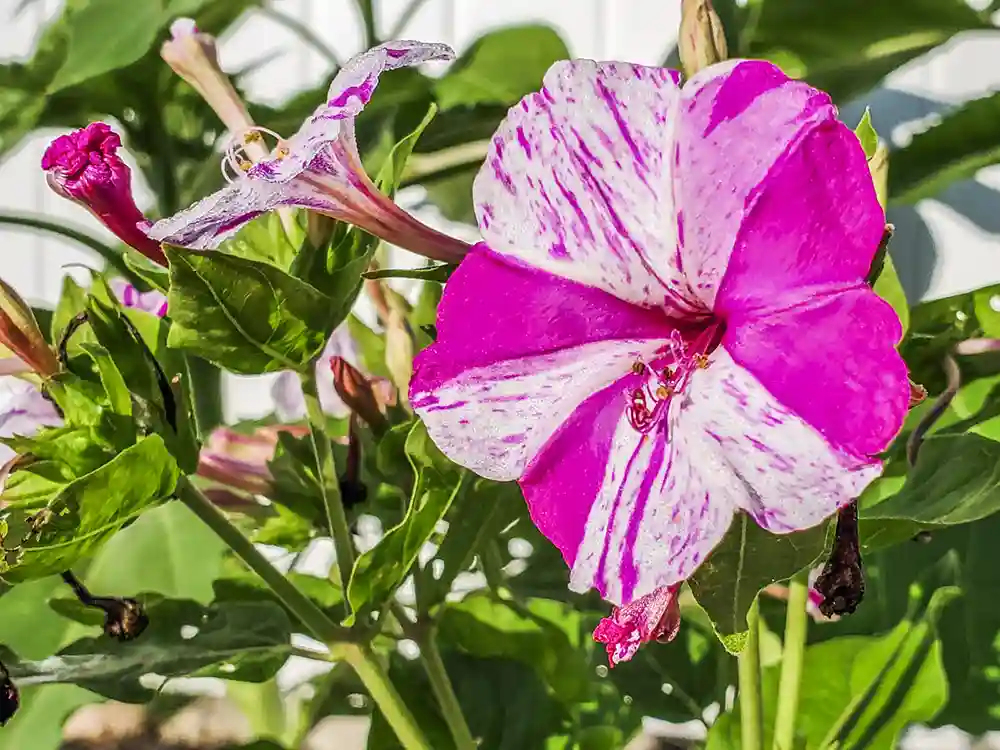If you’re looking to add a splash of color to your garden, then look no further than Four O’Clocks! These beautiful and fragrant flowers are easy to grow from seed and can thrive in a variety of climates. In this guide, we’ll walk you through the steps to successfully grow Four O’Clocks from seed, including tips on planting, care, and troubleshooting common problems.
Why Choose Four O’Clocks?
Four O’Clocks (Mirabilis jalapa) are known for their stunning trumpet-shaped flowers that come in a wide range of colors, including pink, white, yellow, red, and bi-colored varieties.
They are called Four O’Clocks because they typically open their flowers in the late afternoon and remain open until the next morning.
The flowers are not only visually appealing but also emit a sweet fragrance that attracts butterflies and hummingbirds, making them a delightful addition to any garden.
Basic Info
| Common Name | Four O’Clock |
| Scientific Name | Mirabilis jalapa |
| Days to Flowering | 60-80 days from seed |
| Light | Full sun to partial shade |
| Soil | Well-draining, fertile soil |
| Water | Regular watering, moderate drought tolerance |
| Fertilizer | Balanced all-purpose fertilizer during active growth |
| Pests | Aphids, spider mites, whiteflies |
| Diseases | Leaf spots, powdery mildew |
Varieties of Four O’Clocks
Four O’Clocks (Mirabilis jalapa) come in a variety of cultivars that offer different colors, sizes, and growth habits. Here are some popular varieties to consider for your garden:
- ‘Marvel of Peru‘ – This classic variety features large, trumpet-shaped flowers in a wide range of colors including red, pink, yellow, white, and bi-colors. It grows up to 24 inches in height and is known for its prolific blooming.
- ‘Tea Time Mix‘ – This mix includes a range of pastel-colored flowers in shades of pink, lavender, and white. It grows to a height of 18-24 inches and is perfect for adding a soft, romantic touch to your garden.
- ‘Broken Colors‘ – As the name suggests, this unique variety features flowers with broken or variegated colors, creating a beautiful mosaic-like effect. It grows up to 30 inches in height and adds a touch of whimsy to any garden.
- ‘Lemon Swirl‘ – This cultivar features stunning lemon-yellow flowers with a sweet fragrance. It grows up to 24 inches in height and adds a bright burst of color to any garden bed or container.
- ‘Alba‘ – This variety produces pure white flowers and is perfect for creating a moonlit garden theme or for adding a touch of elegance to your garden. It grows up to 24 inches in height and offers a striking contrast to other colorful flowers.
These are just a few examples of the many varieties of Four O’Clocks available. Explore your local nurseries or online seed catalogs to find the ones that best suit your gardening style and preferences.
Best Selling Four O’Clock Varieties
Start Four O’Clocks Seeds Indoors

Get a head start on the growing season. If you have a shorter growing season or live in an area with cold winters, you can grow Four O’Clocks from seed indoors about 6 to 8 weeks before the last expected frost date. Here’s how you can do it:
1. Obtain quality seeds. Four O’Clock seeds are typically large and easy to handle.
2. Fill seed trays or 4” nursery pots with a well-draining potting mix.
3. Sow two seeds per pot about 1/2 inch deep and water lightly.
4. Cover with a humidity dome and place the pots in a warm location.
5. Keep the soil evenly moist but not waterlogged, and avoid overwatering to prevent rot.
6. Use a good grow light for seed starting once the seedlings pop up.
7. Once the seedlings have developed their first set of true leaves, thin them to one plant per pot.
8. Transplant the seedlings outdoors after the danger of frost has passed, and they have acclimated to outdoor conditions.


Moving The Seedlings Outdoors
If you grow Four O’Clocks from seed indoors, it’s important to “harden off” the seedlings before exposing them to full sunlight. Do this by gradually exposing them to outdoor conditions, such as direct sunlight, wind, and temperature changes.
Start with short periods of exposure and gradually increase the duration over 7-10 days. Water the seedlings as needed and protect them from extreme weather conditions. Hardening off seedlings will help them adjust to the new environment and reduce the risk of transplant shock.
Four O’Clocks can also be directly sown outdoors in the garden once the soil has warmed up and the danger of frost has passed.

Direct Sow Four O’Clocks Seeds Outdoors
You can also grow Four O’Clocks from seed by direct sowing outdoors. Here’s how to get started:
- Choose a sunny spot: Choose a location in your garden that receives at least 6 hours of direct sunlight per day.
- Prepare the soil: Four O’Clocks are not picky about soil type and can tolerate a wide range of soil conditions. However, well-drained soil with a pH of 6.0 to 7.0 is ideal. Loosen the soil and remove any weeds or debris.
- Sow the seeds: Plant the seeds about 1/2 inch deep and 12 to 18 inches apart. Water the seeds gently after planting to moisten the soil.
- Keep the soil consistently moist: Avoid overwatering, as this can cause the seeds to rot.
- Germination: Four O’Clock seeds usually germinate within 7 to 14 days, depending on the temperature and growing conditions.
Caring and Maintenance of Four O’Clocks
Four O’Clocks are relatively low-maintenance plants, but they still require some care to ensure healthy growth and abundant blooms. Here are some tips on how to care for your Four O’Clocks:
Watering
Water your Four O’Clocks regularly, keeping the soil consistently moist, but not waterlogged. Water at the base of the plant to avoid wetting the foliage, as this can promote disease.
Fertilizing
They’re not heavy feeders, but a balanced water soluble fertilizer can help promote healthy growth and abundant blooms. Apply a slow-release granular fertilizer or liquid fertilizer diluted to half-strength every 4 to 6 weeks during the growing season.
Pruning
Deadheading spent flowers encourages continuous blooming, remove the spent flowers regularly. This can help redirect the plant’s energy into producing more flowers instead of setting seed.
Mulching
Mulching around the base of the plants can help conserve moisture, suppress weeds, and regulate soil temperature. Use organic mulch, such as straw, shredded leaves, or bark chips, and apply a layer about 2 to 3 inches thick.
Pests and Diseases
Four O’Clocks are generally resistant to pests and diseases, but like any plant, they can still be susceptible to certain issues.
| Pests / Diseases | Symptoms | Treatment |
|---|---|---|
| Aphids | Curling leaves, distorted growth, sticky residue | Blast off with water, use insecticidal soap or neem oil |
| Spider Mites | Webbing, yellowing leaves, stippling | Rinse with water, use insecticidal soap or neem oil |
| Whiteflies | White, fly-like insects on leaves | Use yellow sticky traps, apply insecticidal soap or neem oil |
| Leaf spots | Brown or black spots on leaves | Remove affected leaves, improve air circulation, apply fungicide |
| Powdery Mildew | White powdery coating on leaves | Remove affected leaves, improve air circulation, apply fungicide |
Regularly inspecting your plants for any signs of pests or diseases and taking prompt action can help keep your Four O’Clocks healthy and thriving.
Are Four O’Clocks Annual or Perennial?
Four O’Clocks are typically grown as annual flowers, meaning they complete their life cycle in one growing season. However, in warmer climates (zones 9-11), they can also act as perennials and come back year after year, especially if provided with proper care and protection during winter months.
Collect Seeds for Future Planting
Four O’Clocks are self-fertile and produce seed pods after flowering. You can collect the mature seeds by allowing the pods to dry on the plant, then harvesting and storing them in a cool, dry place until you’re ready to plant them again. Do this allows you to grow Four O’Clocks from seed the following season.
Saving and Planting Four O’Clock Tubers
To save and plant Four O’Clock tubers, dig them up after the first frost, clean them by removing any soil or debris, and allow them to dry for a few days. Once dry, store them in a cool, dry place, such as a paper bag or a box with peat moss or vermiculite. You can grow Four O’Clocks from the tubers by replanting them in spring after the danger of frost has passed. Space them about 12-18 inches apart.
Conclusion
It is a rewarding and enjoyable gardening experience to grow Four O’Clocks from seed whether you start them indoors or direct sow outdoors. With their beautiful flowers, delightful fragrance, and easy-going nature, Four O’Clocks can be a stunning addition to any garden.
By following the tips and techniques outlined in this guide, you can successfully grow Four O’Clocks from seed and enjoy their beauty in your own backyard. Don’t forget to share your gardening tips and experiences in the comments below, and happy gardening!
FAQ: Grow Four O’Clocks from Seed
How long does it take for Four O’Clocks to bloom from seed?
Four O’Clocks typically take around 60-80 days to bloom from seed, depending on growing conditions and variety.
Do Four O’Clock seeds need cold stratification?
No, Four O’Clock seeds do not require cold stratification. They can be sown directly in the garden or started indoors without the need for cold treatment.
Should Four O’Clock seeds be soaked before planting?
Soaking Four O’Clocks seeds in water before planting is not necessary, as they do not require pre-soaking for germination. Simply sow them directly in the soil or in seed trays/pots according to package instructions.
Do hummingbirds like Four O’Clocks?
Yes, hummingbirds are known to be attracted to the tubular flowers of Four O’Clocks, making them a great addition to a hummingbird-friendly garden.
What is a companion plant for Four O’Clocks?
Four O’Clocks are known to be compatible with a variety of companion plants, including marigolds, zinnias, cosmos, and petunias. These plants can be planted nearby to complement the beauty of Four O’Clocks and provide mutual benefits such as pest control and pollination.










